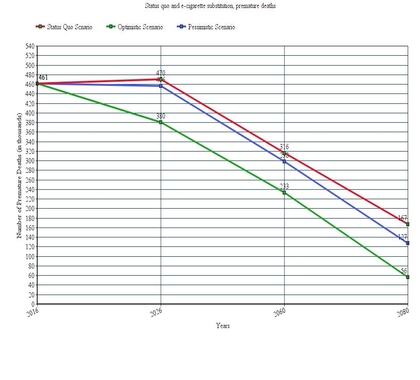A new study published in the October 2017 issue of Tobacco Control, a BMJ peer-reviewed journal, concludes electronic nicotine delivery systems (ENDS), commonly called e-cigarettes or vaping, would help avert deaths if used to replace cigarettes. The study analyzed health outcomes using “a strategy of switching cigarette smokers to e-cigarette use (‘vaping’) in the USA to accelerate tobacco control progress.”
The authors used data from the 1965–2012 National Health Survey to identify the “number of smoking-attributable deaths for current smokers [as] calculated by age, sex and year.” To distinguish the expected risk of e-cigarette use, the authors posit “the risk to former smokers from using e-cigarettes is proportional to the difference in risk between current and former smokers.”
The authors determined the replacement of ENDS for tobacco cigarettes would result in an estimated 6.6 million fewer deaths and more than 86 million fewer life-years-lost.
The study furthers the validity of other studies that also found vaping is less harmful than combustible cigarettes. In 2015, Public Health England declared ENDS are less harmful than tobacco cigarettes, noting its research found “the current best estimate [shows] using [ENDS] is around 95% safer than smoking.”
A 2016 report by the Tobacco Advisory Group of the Royal College of Physicians found health hazards from ENDS were “unlikely to exceed 5% of the harm from smoking tobacco,” and these products have created “a massive opportunity for a consumer – as well as healthcare – led revolution in the way nicotine is used in society.”
In September 2017, NHS Health Scotland issued a joint statement with other health agencies declaring “vaping e-cigarettes is less harmful than smoking tobacco.”
In addition to ENDS providing important health benefits, research shows they could also save taxpayers billions of dollars. J. Scott Moody, chief executive officer and chief economist at State Budget Solutions, estimated savings to Medicaid could have amounted to $48 billion in 2012 if ENDS had been adopted in place of tobacco cigarettes.
It is important for policymakers to acknowledge ENDS is and could continue to be an important tobacco-harm reduction tool, and they should embrace, not diminish, their usefulness by repealing or avoiding burdensome taxes and regulations that mimic those applied to tobacco products.
The following articles provide more information about ENDS products and tobacco harm reduction.
Vaping, E-Cigarettes, and Public Policy Toward Alternatives to Smoking
https://heartland.org/publications-resources/publications/vaping-e-cigarettes-and-public-policy-toward-alternatives-to-smoking
For decades, lawmakers and regulators have used taxes, bans, and burdensome regulations as part of their attempt to reduce the negative health effects of smoking. Recently, some have sought to extend those policies to electronic cigarettes. This booklet from The Heartland Institute urges policymakers to re-think that tax-and-regulate strategy. Policymakers should be mindful of the extensive research that supports tobacco harm reduction and understand bans, excessive regulations, and high taxes on e-cigarettes often encourage smokers to continue using more-harmful traditional cigarette products.
Research & Commentary: Public Health Officials Urge Use of Electronic Nicotine Delivery Systems
https://heartland.org/publications-resources/publications/public-health-officials-urge-use-of-electronic-nicotine-delivery-systems
In this Research & Commentary, Heartland Institute State Government Relations Manager Lindsey Stroud notes the importance of NHS Health Scotland’s joint statement encouraging the use of electronic nicotine delivery systems (ENDS) as an alternative to tobacco products. NHS Health Scotland, Public Health England, and other groups have found ENDS are 95 percent less harmful than tobacco cigarettes.
Research & Commentary: Electronic Cigarettes
http://heartland.org/policy-documents/research-commentary-electronic-cigarettes
Heartland Institute Senior Policy Analyst Matthew Glans examines electronic cigarettes, tobacco harm reduction, and various proposals to regulate e-cigarette use. E-cigarettes have become one of the most popular nicotine replacement products and a key building block in tobacco harm reduction strategies.
Nicotine without smoke: Tobacco harm reduction
https://heartland.org/policy-documents/nicotine-without-smoke-tobacco-harm-reduction
This report aims to provide a fresh update on the use of harm reduction in tobacco smoking, in relation to all non-tobacco nicotine products but particularly e-cigarettes. It concludes that, for all the potential risks involved, harm reduction has huge potential to prevent death and disability from tobacco use, and to hasten our progress to a tobacco-free society.
Research & Commentary: New CDC Report Finds Vaping Helps Smokers Quit
https://heartland.org/policy-documents/research-commentary-new-cdc-report-finds-vaping-helps-smokers-quit
A report released by the Centers for Disease Control and Prevention (CDC) found only 0.4 percent of the people who had never smoked tobacco in a CDC study group are current vapers, which the report defines as using a vaping device either every day or some days. The CDC report, the first of its kind, estimates e-cigarette use among U.S. adults using a nationally representative household survey. The report finds only 3.4 percent of adults who have never smoked have tried an e-cigarette; 12.6 percent of Americans have tried an e-cigarette; and fewer than 4 percent of the U.S. population are regular e-cigarette users.
E-Cigarettes Poised to Save Medicaid Billions
https://heartland.org/policy-documents/e-cigarettes-poised-save-medicaid-billions
In a new report from State Budget Solutions, J. Scott Moody finds e-cigarette use could create significant savings for state governments, especially in their Medicaid programs: “As shown in this study, the potential savings to Medicaid significantly exceeds [sic] the state revenue raised from the cigarette excise tax and tobacco settlement payments by 87%. As such, the rational policy decision is to adopt a non-interventionist stance toward the evolution and adoption of the e-cig until hard evidence proves otherwise.”




